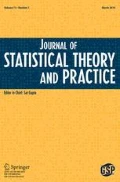Abstract
We do a thorough mathematical study of the notion of full conglomerability, that is, conglomerability with respect to all the partitions of an infinite possibility space, in the sense considered by Peter Walley. We consider both the cases of precise and imprecise probability (sets of probabilities). We establish relations between conglomerability and countable additivity, continuity, super-additivity, and marginal extension. Moreover, we discuss the special case where a model is conglomerable with respect to a subset of all the partitions, and try to sort out the different notions of conglomerability present in the literature. We conclude that countable additivity, which is routinely used to impose full conglomerability in the precise case, appears to be the most well-behaved way to do so in the imprecise case as well by taking envelopes of countably additive probabilities. Moreover, we characterize these envelopes by means of a number of necessary and sufficient conditions.
Similar content being viewed by others
References
Armstrong, T. 1990. Conglomerability of probability measures on Boolean algebras. Journal of Mathematical Analysis and Applications 150:335–58.
Armstrong, T., and K. Prikry. 1982. The semi-metric on a Boolean algebra induced by a finitely additive probability measure. Pacific Journal of Mathematics 99:249–64.
Augustin, T., F. Coolen, G. de Cooman, and M. Troffaes, eds. 2014. Introduction to imprecise Probabilities. Hoboken, NJ: Wiley.
Berti, P., and P. Rigo. 1992. Weak disintegrability as a form of preservation of coherence. Journal of the Italian Statistical Society 1 (2):161–82.
Berti, P., E. Regazzini, and P. Rigo. 1991. Coherent statistical inference and Bayes theorem. The Annals of Statistics 19 (1):366–81.
Bogachev, V. 2007. Measure Theory. Berlin-Heidelberg: Springer.
Cantelli, F. P. 1935. Sulla estensione del principio delle probabilità totali ad una successioni illimitata di eventi incompatibili. Gior. Ist. It. Attuari 6 (4):415–27.
de Finetti, B. 1930. Sulla proprietà conglomerativa delle probabilità subordinate. Rendiconti del Reale Instituto Lombardo 63:414–18.
de Finetti, B. 1970. Teoria delle probabilità. Turin, Italy: Einaudi.
de Finetti, B. 1972. Probability, induction and statistics. London, UK: Wiley.
de Finetti, B. 1974–1975. Theory of probability: A critical introductory treatment. Chichester, UK: John Wiley & Sons. English translation of de Finetti (1970), two volumes.
Denneberg, D. 1994. Non-additive measure and integral. Dordrecht, The Netherlands: Kluwer Academic.
Doria, S. 2011. Coherent upper and lower conditional previsions defined by Hausdorff outer and inner measures. In Modeling, design and simulation of systems with uncertainties, ed. A. Rauth and E. Auer, 175–95. Berlin-Heidelberg: Springer.
Doria, S. 2015. Symmetric coherent upper conditional prevision defined by the Choquet integral with respect to Hausdorff outer measure. Annals of Operations Research 229 (1):377–96.
Dubins, L. E. 1974. On Lebesgue-like extensions of finitely additive measures. Annals of Probability 2:456–63.
Dubins, L. E. 1975. Finitely additive conditional probabilities, conglomerability and disintegrations. Annals of Probability 3:88–99.
Joshi, K. D. 1983. Introduction to general topology. New Delhi: New Age International.
Kadane, J. B., M. J. Schervisch, and T. Seidenfeld. 1986. Statistical implications of finitely additive probability. In Bayesian inference and decision techniques, ed. P. K. Goel and A. Zellner, 59–76. New York: Elsevier Science. Reprinted in Seidenfeld et al. (1999, Chapter 2.5).
Krätschmer, V. 2003. When fuzzy measures are upper envelopes of probability measures. Fuzzy Sets and Systems 138:455–68.
Miranda, E., and M. Zaffalon. 2010. Notes on desirability and conditional lower previsions. Annals of Mathematics and Artificial Intelligence 60 (3–4):251–309.
Miranda, E., and M. Zaffalon. 2013. Conglomerable coherence. International Journal of Approximate Reasoning 54 (9):1322–50.
Miranda, E., and M. Zaffalon. 2015. On the problem of computing the conglomerable natual extension. International Journal of Approximate Reasoning 56:1–27.
Miranda, E., M. Zaffalon, and G. de Cooman. 2012. Conglomerable natural extension. International Journal of Approximate Reasoning 53 (8):1200–27.
Moral, S. 2005. Epistemic irrelevance on sets of desirable gambles. Annals of Mathematics and Artificial Intelligence 45:197–214.
Petturiti, D., and B. Vantaggi. 2017. Envelopes of conditional probabilities extending a strategy and a prior probability. International Journal of Approximate Reasoning 81:160–82.
Schervisch, M. J., T. Seidenfeld, and J. B. Kadane. 1984. The extent of non-conglomerability of finitely additive probabilities. Zeitschrift fur Wahrscheinlichkeitstheorie und verwandte Gebiete 66:205–26.
Schervisch, M. J., T. Seidenfeld, and J. B. Kadane. 2014. On the equivalence between conglomerability and disintegrability for unbounded random variables. Statistical Methods and Applications. Journal of the Italian Statistical Society 23 (4):501–18.
Seidenfeld, T., M. J. Schervish, and J. B. Kadane. 1998. Non-conglomerability for finite-valued finitely additive probability. Sankhya 60 (3):476–91.
Seidenfeld, T., M. J. Schervish, and J. B. Kadane. 1999. Rethinking the foundations of statistics. Cambridge, UK: Cambridge University Press.
Seidenfeld, T., M. J. Schervish, and J. B. Kadane. 2013. Two theories of conditional probability and non-conglomerability. In ISIPTA ‘13: Proceedings of the Eighth International Symposium on Imprecise Probability: Theories and Applications, ed. F. Cozman, T. Denœux, S. Destercke, and T. Seidenfeld, 295–302. NJ: Compiègne, France: SIPTA.
Troffaes, M., and G. de Cooman. 2014. Lower previsions. Hoboken, UK: Wiley. 2014.
Ulam, S. 1930. Zur masstheorie in der allgemeinen mengenlehre. Fundamenta Mathematicae 16:140–50.
Walley, P. 1981. Coherent lower (and upper) probabilities. Statistics Research Report 22, University of Warwick, Coventry, UK.
Walley, P. 1991. Statistical reasoning with imprecise probabilities. London, UK: Chapman and Hall.
Williams, P. M. 1975. Notes on conditional previsions. Technical report, School of Mathematical and Physical Science, University of Sussex, Brighton, UK. Reprinted as Williams (2007).
Williams, P. M. 2007. Notes on conditional previsions. International Journal of Approximate Reasoning 44:366–83. Revised journal version of Williams (1975).
Zaffalon, M., and E. Miranda. 2013. Probability and time. Artificial Intelligence 198 (1):1–51.
Author information
Authors and Affiliations
Corresponding author
Rights and permissions
About this article
Cite this article
Miranda, E., Zaffalon, M. Full conglomerability. J Stat Theory Pract 11, 634–669 (2017). https://doi.org/10.1080/15598608.2017.1295890
Received:
Accepted:
Published:
Issue Date:
DOI: https://doi.org/10.1080/15598608.2017.1295890
Keywords
- Full conglomerability
- countable additivity
- continuity
- marginal extension
- imprecise probability
- lower previsions




